SCDF to roll out new ambulance that can self-decontaminate and automatically load stretcher
 April 15, 2021
April 15, 2021
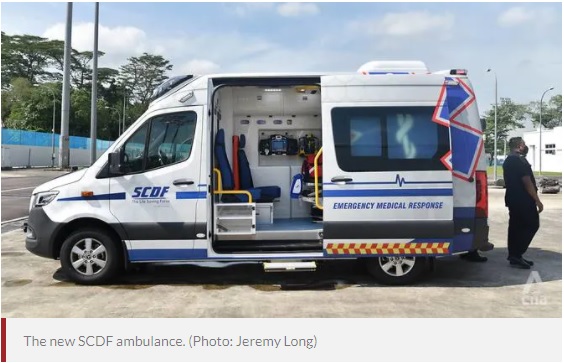
SINGAPORE: The Singapore Civil Defence Force (SCDF) has unveiled its new seventh-generation ambulance that can self-decontaminate and automatically load or unload stretchers to reduce the risk of accidental drops.
The ambulance, which has blue strips on its exterior instead of the usual red, also comes with a modular storage system that allows medical equipment to be rearranged or carried around easily.
For the ambulance driver, new safety features include a 360-degree vehicle camera and parking assistance.
Lieutenant-Colonel (Lt Col) Janice Oh, senior assistant director at SCDF’s Emergency Medical Services Department, said the force will roll out 26 of these new ambulances in August. They will first replace the fifth-generation ambulances before the entire fleet eventually.
Lt Col Oh told reporters on Wednesday (Apr 14) that the new ambulance has to deal with current and future pre-hospital emergency challenges, including the threat of future pandemics.
“Essentially, the new ambulance’s future-proofed capabilities will allow our emergency medical services to operate more effectively and efficiently,” she said at an SCDF showcase as part of its annual work plan seminar.
The ambulance was developed with the Home Team Science and Technology Agency.
SELF-DECONTAMINATION
The new ambulance’s in-built decontamination system is designed to “rapidly and effectively” sanitise the interior and equipment after transporting infectious patients, SCDF said on Thursday.

It comprises a mist system that sprays vital oxide, a non-toxic and non-corrosive disinfectant, to decontaminate the ambulance in 20 minutes, SCDF said, adding that this is done with the press of a button with no wipe-down needed.
During the COVID-19 pandemic, SCDF personnel decontaminate ambulances that have transported infectious patients using individual misting devices that are stored in hospitals. This process could take one hour.
“This (new) system decreases the ambulance’s operational downtime significantly, and increases personnel safety,” SCDF said.
For even better hygiene, the driver and front passenger seats will be fitted with removable anti-bacterial leatherette covers.
ELECTRONIC STRETCHER LOADING
The system that automatically loads and unloads stretchers uses electronic pulleys to make the process “extremely easy, eliminating the operator’s effort”, SCDF said.
“This system reduces the risk of accidental stretcher drops during loading and unloading,” it said, adding that the system is powered by an independent battery.
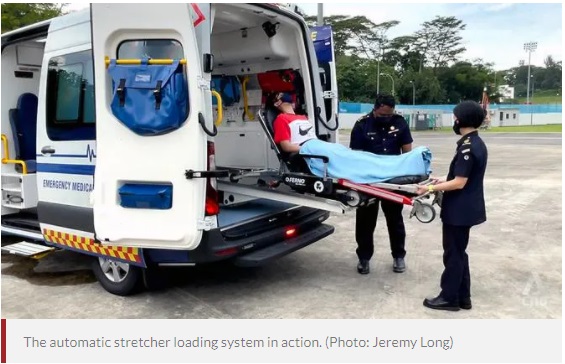
Still, the system requires some human intervention for safety. Personnel can control the unloading speed and must ensure the stretcher wheels are engaged before it is released on the ground.
While the automatic loading or unloading process takes about 30 seconds, slower than when it is done manually, SCDF believes in the added safety for both patients and personnel.
MODULAR STORAGE SYSTEM
The new ambulance’s modular storage system features wall-mounted tracks that enables the interior to be reconfigured easily based on operational needs.
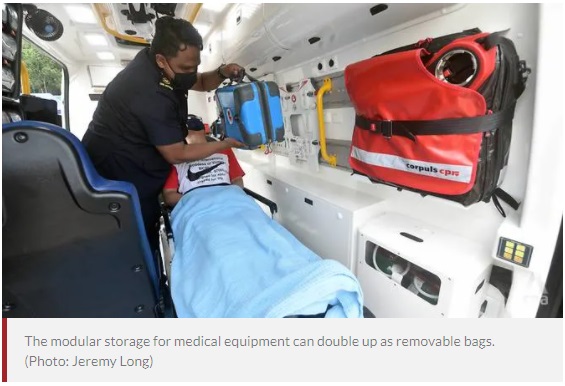
A wall cabinet can also double up as a bag that can be removed for portability and to reduce inventory space.
“This system allows the ambulance to be quickly unloaded during servicing, thus reducing operational downtime,” SCDF said, adding that it also improves workflow and inventory management.
SOLAR POWERED CHARGING
The new ambulance has three solar panels on its roof to charge the batteries that power its electronic devices and equipment.
This is especially useful as ambulances are deployed during major events or at non-fixed locations like community centres to reduce response times. These locations usually do not have electrical chargers for the ambulance’s batteries.
SCDF said the solar panels guarantee high efficiency even in low light conditions, and slows wear and tear on the batteries to reduce cost.
An intelligent charging system prioritises and diverts power to critical equipment on board the ambulance, including communication, emergency lights and navigation.
“In addition to reduced fuel consumption, these two new features enable more electrical components to be added in future,” SCDF added.
VEHICLE SAFETY AND OTHER FEATURES
The new ambulance will also come with a height limit detector that can determine gantry heights and warn its driver up to 50m away. This reduces overhead accidental damage, SCDF said.
While the height limit for SCDF ambulances is 2.8m, these limits can be calibrated for individual vehicles.
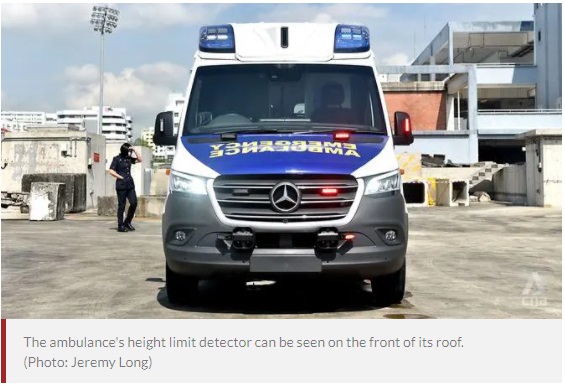
A 360-degree camera, which provides a video feed on the driver’s centre console, gives the driver a bird’s eye view with audio and visual warnings when parking and maneuvering. This reduces the risk of collisions, SCDF said.
An intercom has also been installed in the front and rear cabin for ease of communication.
Moving on to software, the new ambulance will be equipped with the Operational Medical Networks Informatics Integrator (OMNII), which will be implemented in the second half of this year.
OMNII is a next-generation collaborative platform that links stakeholders like SCDF in the pre-hospital emergency care services, SCDF said.
“It enables authorised parties to view, document, and share relevant patient information throughout the pre-hospital emergency care journey to improve patient care management,” it added.
NEW COMMAND VEHICLES
Also as part of its work plan seminar, the SCDF announced that it will introduce new command vehicles that allow commanders to better manage different emergencies.
These command vehicles, carrying senior SCDF officers like division commanders or its commissioner, are deployed near an emergency site for command and control over the SCDF’s response.
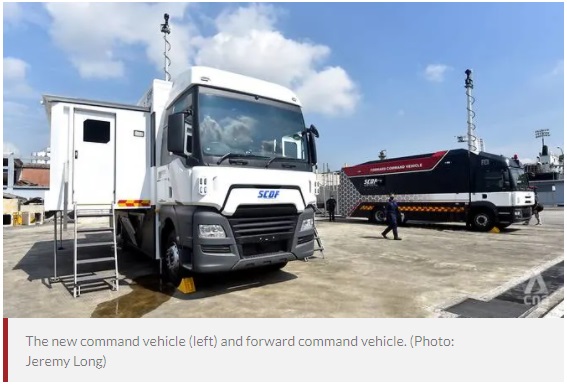
The new command vehicles will come with a 12m-tall camera mast with 30 times zoom to monitor the incident site, as well as a large screen with multiple video feeds to show visual and map information from different sources, including body cameras and SCDF drones.
SCDF said it will roll out the new command vehicles progressively from July.
HOW THE COMMAND VEHICLES ARE DEPLOYED
While routine emergencies like small residential fires would trigger the deployment of standard platforms like fire trucks, with a fire station commander as the overall incident manager, more severe emergencies like larger factory fires would require a more comprehensive response.
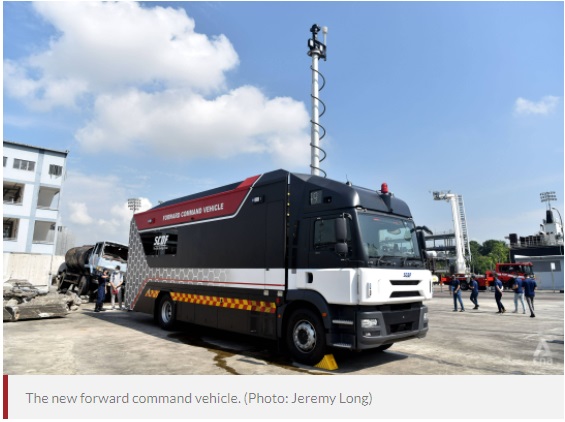
In the latter case, additional platforms and the forward command vehicle (FCV) are deployed, with the division commander acting as the overall incident manager.
During bigger incidents like a structural building collapse, leak of hazardous materials or an air crash, five command vehicles (CV) are deployed in addition to the FCV, with the SCDF commissioner acting as the overall incident manager.
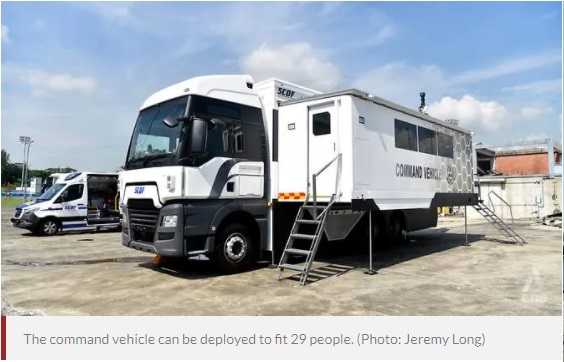
Each CV serves distinct functions, including command and operations, joint-planning with related agencies, and the management of logistics, information and communications technology, as well as media.
CVs have been deployed during the mega oil tank fire on Pulau Busing in 2018, and the Nicoll Highway collapse in 2004.
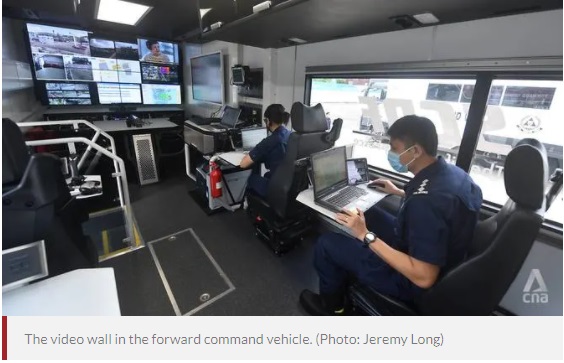
The current CVs and FCVs have been in operation since the early 2000s, and the SCDF said the “ageing fleet” is due for replacement, calling it “timely” to improve capabilities to manage increasingly complex operational terrains.
“We believe that these new capabilities will certainly enhance how our commanders and decision-makers are able to see more, see further and know more … and also improve the overall quality of incident management,” SCDF director of operations Senior Assistant Commissioner (SAC) Daniel Seet said.
VIDEO WALLS AND DRONES
Both the new CV and FCV will come with the retractable mast that can monitor the weather and shine a spotlight, in addition to surveilling the incident site in the day or at night.
Inside these vehicles, a mega screen can show 12 video feeds from various sources. This includes news or radio channels, CCTVs from related agencies, body cameras worn by responders on the ground, as well as cameras on SCDF vehicles and equipment, including drones.
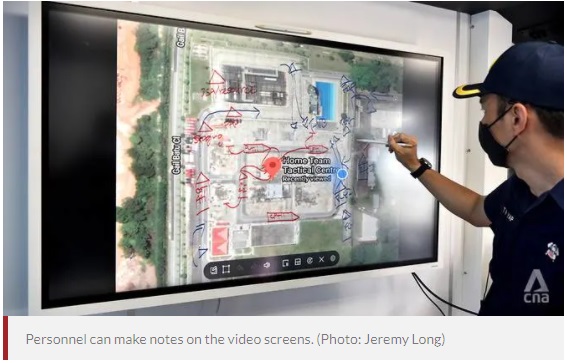
Personnel can project information and applications from mobile devices on the screen using wireless technology, an upgrade from the wired connections on the current vehicles.
The 12 feeds can be configured to display in different sizes or combinations. In contrast, the current CVs and FCVs only have three screens.
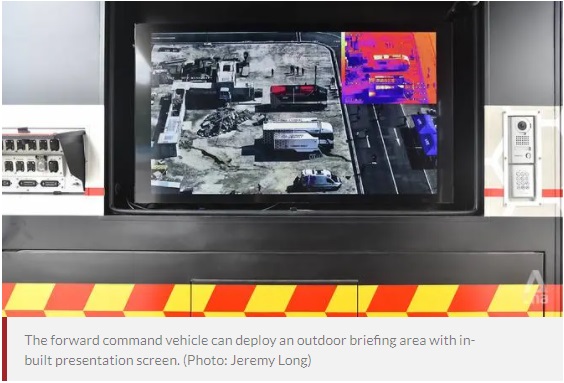
“The video wall canvas streamlines information gathering, translating these data into visual dashboards with actionable insights for SCDF commanders to make mission-critical decisions,” SCDF said.
Operations personnel in these vehicles also have dedicated work stations that log actions taken, simulate scenarios and conduct terrain mapping.
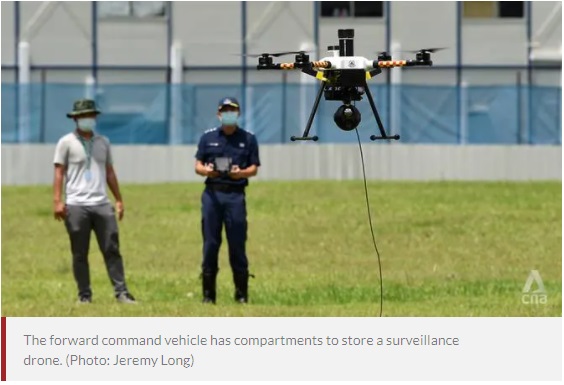
The FCV’s drone, which can be upgraded to conduct 3D terrain mapping, is able to fly up to 100m in the sky while on a tethered connection to provide a persistent and higher vantage point for commanders monitoring the incident.
The CV, which can be mechanically expanded using one button to fit more people than the FCV, can also be deployed by two officers in less than 20 minutes, compared to the four officers taking 30 minutes for the current CV.
The CV’s cabin, when expanded, measures more than 6m long and wide and can fit 29 people when deployed.
IMPROVED WORK EFFICIENCY
The new CVs and FCVs, developed together with the Defence Science and Technology Agency and ST Engineering, are also designed with clear planning and operations areas to reduce work disruption during operations.
“The design integrates human factors engineering to optimise conditions for prolonged deployment and minimise operational fatigue,” SCDF said.
This includes putting table and seats at a “comfortable height” based on recommended head tilt and eye rotation angles.

SAC Seet said the spaces and work stations are organised intuitively in terms of how officers are “functionally clustered” when they monitor incidents.
“We believe that this will also have a very positive impact in terms of how our information flow and processes are,” he added.
“Over the next few months, the SCDF will be going through the paces to learn how we operate this system as well as the capability support, and we really look forward to putting these vehicles into operations very soon.”
Source: CNA/hz
















































